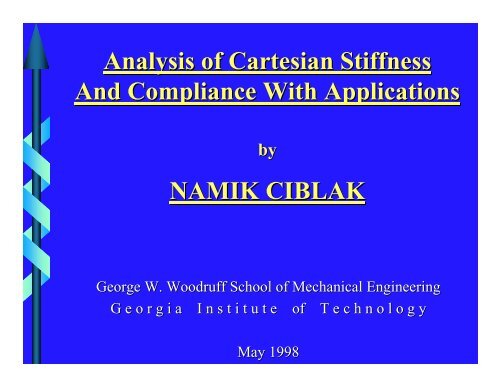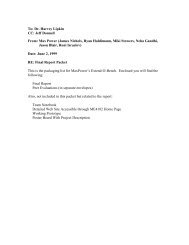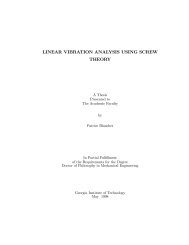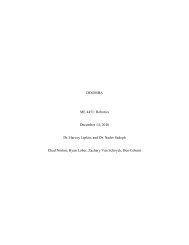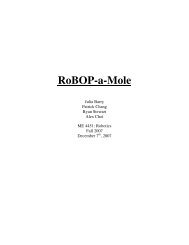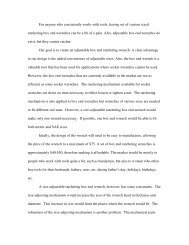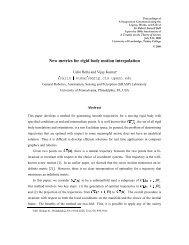Analysis of Cartesian Stiffness And Compliance With ... - helix
Analysis of Cartesian Stiffness And Compliance With ... - helix
Analysis of Cartesian Stiffness And Compliance With ... - helix
You also want an ePaper? Increase the reach of your titles
YUMPU automatically turns print PDFs into web optimized ePapers that Google loves.
<strong>Analysis</strong> <strong>of</strong> <strong>Cartesian</strong> <strong>Stiffness</strong><br />
<strong>And</strong> <strong>Compliance</strong> <strong>With</strong> Applications<br />
by<br />
NAMIK CIBLAK<br />
George W. Woodruff School <strong>of</strong> Mechanical Engineering<br />
G e o r g i a I n s t i t u t e <strong>of</strong> T e c h n o l o g y<br />
May 1998
What is <strong>Stiffness</strong> and <strong>Compliance</strong> ?<br />
∆(configuration)<br />
<strong>Stiffness</strong><br />
∆(load)<br />
∆(load)<br />
<strong>Compliance</strong><br />
∆(configuration)<br />
1
Elastically Suspended Rigid Body Model<br />
P´<br />
loads<br />
rigid<br />
body<br />
P´<br />
loads<br />
elastic system<br />
elastic<br />
connection<br />
2
Robotic Examples<br />
Cooperating robots, assembly robots<br />
z<br />
x<br />
Insertion tasks<br />
Grasp problems:<br />
• stability<br />
• shifting contacts<br />
• object manipulation<br />
3
Why is <strong>Stiffness</strong> Important ?<br />
high<br />
stiffness<br />
→<br />
greater<br />
accuracy<br />
low<br />
stiffness<br />
→<br />
better interaction<br />
with environment<br />
4
Examples <strong>of</strong> High and Low <strong>Stiffness</strong> Devices<br />
Actuators<br />
Deformable<br />
beams<br />
RCC center<br />
Base<br />
Geometric center<br />
A generic Stewart Platform device.<br />
An example <strong>of</strong> high stiffness<br />
parallel mechanism. Good<br />
positional accuracy due to high<br />
stiffness.<br />
A Remote-Center-<strong>of</strong>-<strong>Compliance</strong><br />
(RCC) device. An example <strong>of</strong> a<br />
compliant parallel mechanism. Low<br />
stiffness facilitates insertion and<br />
assembly tasks.<br />
5
•<br />
P<br />
Screws: Twist<br />
v P<br />
: linear velocity : angular velocity<br />
•<br />
hω<br />
Q<br />
≡<br />
ω PQ<br />
v P<br />
ω<br />
•<br />
P<br />
ω<br />
• Q<br />
Chasle’s Theorem: The instantaneous velocity can be given as a<br />
rotation about a certain axis plus a translation parallel to the axis.<br />
T<br />
^<br />
P =<br />
v P<br />
ω<br />
6
Screws: Wrench<br />
f<br />
m P<br />
f<br />
•<br />
P<br />
PQ<br />
Q<br />
≡<br />
Poinsot’s Theorem: Any load on a body can be represented by a force along a<br />
certain axis plus a moment parallel to the axis.<br />
^<br />
W P<br />
=<br />
h f<br />
• Q<br />
•<br />
P<br />
f<br />
m P<br />
7
Screw Axis and Pitch<br />
ha<br />
h: pitch<br />
b P<br />
a<br />
a<br />
•<br />
P<br />
•<br />
screw axis<br />
On the screw axis,<br />
• displacements and velocities are similar to the kinematics <strong>of</strong> a simple screw.<br />
• loads are similar to the force and torque relation for a simple screw.<br />
8
n-Systems <strong>of</strong> Screws<br />
All screws in an n-system can be given as linear<br />
combinations <strong>of</strong> n basis elements.<br />
A 2-system<br />
9
Principal Screws & Center <strong>of</strong> 3-Systems<br />
There exists a special basis for 3-systems whose elements<br />
are called the principal screws (Ball).<br />
A 3-system<br />
10
Free-Vectors (Infinite Pitch Screws)<br />
Infinite pitch screw<br />
Pure translation<br />
Infinite pitch screw<br />
Pure moment<br />
11
Line-Vectors (Zero Pitch Screws)<br />
line <strong>of</strong> action<br />
ω<br />
ω<br />
zero pitch screw<br />
Pure rotation<br />
f<br />
f<br />
zero pitch screw<br />
Pure force<br />
12
Line-Vector Subspaces<br />
pencil<br />
bundle<br />
❂ Examples <strong>of</strong> bundles: Set <strong>of</strong> all rotations or forces through a point.<br />
❂ 3-D case is not unique. Every point in space generates a bundle.<br />
13
Spatial Cross Product<br />
Screw space admits a vector multiplication called the<br />
spatial cross product operation.<br />
^<br />
S 1<br />
a<br />
× 1<br />
S ^ a ×<br />
1<br />
2 = × =<br />
b 2<br />
b 1<br />
a 2<br />
b 1<br />
0<br />
× a 1 ×<br />
a 2<br />
b 2<br />
14
Definitions <strong>of</strong> <strong>Stiffness</strong> and <strong>Compliance</strong><br />
^<br />
δq : infinitesimal spatial displacement (twist).<br />
^<br />
dW: infinitesimal spatial force (wrench).<br />
stiffness<br />
^ ^ ^<br />
dW = K δq<br />
6x1 6x6 6x1<br />
compliance<br />
^ ^ ^<br />
dq = C δW<br />
6x1 6x6 6x1<br />
The 3x3 submatrices <strong>of</strong> stiffness and compliance<br />
^<br />
K =<br />
A<br />
B T<br />
B<br />
C<br />
^<br />
C =<br />
D<br />
E<br />
E T<br />
C<br />
15
Eigenvalue (EV) Problems<br />
❂ Complicated physical phenomena may be explained in terms that make sense<br />
to human mind.<br />
❂ Geometric and constitutive contents are separated.<br />
^ a<br />
K = λ<br />
b<br />
twist<br />
wrench<br />
a<br />
b<br />
twist<br />
not meaningful<br />
16
Free-Vector EV Problems (Lipkin and Patterson)<br />
^ f<br />
C =<br />
τ<br />
wrench<br />
a f<br />
f<br />
0<br />
parallel<br />
translation<br />
^ δ 0<br />
K = k γ<br />
γ γ<br />
twist<br />
parallel<br />
couple<br />
eigenwrench<br />
^<br />
W fi<br />
^<br />
T γi<br />
eigentwist<br />
parallel<br />
translation<br />
f i<br />
γ i<br />
parallel<br />
couple<br />
(Dimentberg’s problem)<br />
(Correct dualization)<br />
• There exist three eigentwists and three eigenwrenches.<br />
• Eigenvalues are the stationary values.<br />
17
Free-Vector Decompositions<br />
K^ =<br />
f<br />
τ<br />
k f<br />
0<br />
γ 0<br />
0<br />
k γ<br />
f<br />
τ<br />
0<br />
γ<br />
T<br />
a f<br />
f δ<br />
C^ =<br />
0 γ 0<br />
0<br />
a γ<br />
f δ<br />
0 γ<br />
T<br />
geometric<br />
constitutive<br />
geometric<br />
18
Center <strong>of</strong> Elasticity<br />
The centers <strong>of</strong> the eigentwist and eigenwrench 3-systems<br />
coincide (Lipkin and Patterson).<br />
<br />
<br />
<br />
<br />
<br />
<br />
<br />
<br />
<br />
<br />
19
Coplanar Perpendicular Vectors<br />
f 2<br />
f 3<br />
r f2<br />
E<br />
r f3<br />
E<br />
E<br />
r f1<br />
E<br />
f 1<br />
Lipkin and Patterson:<br />
Σ r E<br />
fi<br />
=<br />
Σ r E<br />
γ i<br />
=<br />
0<br />
20
Location <strong>of</strong> Center <strong>of</strong> Elasticity<br />
f i<br />
r fi<br />
E<br />
E<br />
r fi<br />
r E<br />
O<br />
r E<br />
= 1 Σ 2 r ( fi r E<br />
= 1 Σ 2 r ) γ i<br />
21
Centers <strong>of</strong> <strong>Stiffness</strong> <strong>And</strong> <strong>Compliance</strong><br />
Loncaric:<br />
B T = B<br />
B T ≠ B<br />
O<br />
S<br />
(Center <strong>of</strong> <strong>Stiffness</strong>)<br />
E T ≠ E<br />
C<br />
E T = E<br />
(Center <strong>of</strong> <strong>Compliance</strong>)<br />
^<br />
K =<br />
A<br />
B T<br />
B<br />
C<br />
^<br />
C =<br />
D<br />
E<br />
E T<br />
C<br />
22
Constitutive Character <strong>of</strong> the Centers <strong>of</strong><br />
<strong>Stiffness</strong> and <strong>Compliance</strong><br />
Σ k r S fi fi = 0<br />
Σk r C γ i γ i = 0<br />
23
Line-Vector EV Problems<br />
^ n<br />
C =<br />
m<br />
wrench<br />
a m<br />
0<br />
m<br />
parallel<br />
rotation<br />
^ t<br />
K =<br />
w<br />
twist<br />
t<br />
k t 0<br />
parallel<br />
force<br />
co-eigenwrench at G<br />
co-eigentwist at G<br />
force<br />
G<br />
couple<br />
at G<br />
parallel<br />
rotation<br />
at G<br />
parallel<br />
force<br />
at G<br />
rotation<br />
G<br />
translation<br />
at G<br />
• Every point G in space generates a distinct second EV problem.<br />
• There exist three co-eigentwists and three co-eigenwrenches for every G.<br />
24
Line-Vector Decompositions<br />
^<br />
K G =<br />
n<br />
m<br />
k m<br />
t<br />
0 0<br />
0<br />
k t<br />
n<br />
m<br />
t<br />
0<br />
T<br />
^<br />
C G =<br />
0<br />
m<br />
t a m 0 0<br />
w 0 a t m<br />
t<br />
w<br />
T<br />
geometric<br />
constitutive<br />
geometric<br />
Every generator G yields a distinct decomposition.<br />
25
Co-Center <strong>of</strong> Elasticity<br />
Symmetric A -1 B (E T F -1 ) ⇔ Center <strong>of</strong> Elasticity<br />
Symmetric C -1 B T (ED -1 ) ⇔ Co-center <strong>of</strong> Elasticity<br />
^<br />
K =<br />
A<br />
B T<br />
B<br />
C<br />
^<br />
C =<br />
D<br />
E<br />
E T<br />
C<br />
26
Co-Centers <strong>of</strong> Elasticity<br />
C a<br />
C b<br />
G b<br />
G d<br />
C c<br />
G a<br />
G c<br />
G e<br />
C e<br />
C d<br />
C=G ⇒ E c<br />
• There exists at least one co-center for every stiffness (compliance).<br />
• There may be more than one co-centers.<br />
27
Distribution <strong>of</strong> Co-centers<br />
General case<br />
E<br />
Special cases<br />
E<br />
28
Compliant Axes<br />
^<br />
W fi<br />
pure force<br />
^<br />
T γ i<br />
pure rotation<br />
h fi<br />
=0 h γi<br />
=0<br />
f i<br />
γ i<br />
parallel<br />
translation<br />
parallel<br />
couple<br />
29
Relations Between Centers<br />
^<br />
W fi<br />
^<br />
( T γi<br />
)<br />
^<br />
W fi<br />
^<br />
( T γi<br />
)<br />
E (E c )<br />
⇔<br />
S (C)<br />
S<br />
E<br />
E c<br />
C<br />
a compliant axis<br />
Two or three<br />
compliant axes exist<br />
⇒<br />
E<br />
E c<br />
C<br />
S<br />
30
Generalization <strong>of</strong> <strong>Compliance</strong> Axes<br />
G<br />
t<br />
f<br />
generalized<br />
force-translation<br />
axis<br />
⇔<br />
G<br />
γ<br />
m<br />
generalized<br />
rotation-couple<br />
axis<br />
G<br />
f<br />
i<br />
t<br />
i<br />
force-translation<br />
axis<br />
⇔<br />
G<br />
γ<br />
i<br />
m<br />
i<br />
rotation-couple<br />
axis<br />
31
A New Pair <strong>of</strong> Special Axes<br />
pure force<br />
(E*<br />
cW/B )<br />
h f = 0<br />
f<br />
force-rotation<br />
axis<br />
w<br />
pure rotation<br />
(E cT/A )<br />
h w = 0<br />
rotation-force<br />
axis<br />
32
Asymmetric <strong>Stiffness</strong>: Parallel Line-Springs<br />
Model:<br />
P<br />
W<br />
^<br />
P ’<br />
F’<br />
B’ i B’ n<br />
B’ 1<br />
s i<br />
l i<br />
, k i<br />
A 1<br />
A i A n<br />
O F<br />
F’<br />
F<br />
Finite displacements are considered.<br />
33
<strong>Stiffness</strong> Matrix <strong>of</strong> Line Springs<br />
^ ^ ^<br />
K = Σ<br />
T ^<br />
k i [ ρ i S i S i + (1-ρ i )M i ]<br />
ρ i = l 0i<br />
l i<br />
For all springs are unextended (ρ i = 1):<br />
^<br />
^ ^<br />
K = Σ k i S i S i<br />
T<br />
34
Skew-symmetric Property<br />
^ ^ 1 ^<br />
2<br />
K = K sym - W ×<br />
W^<br />
net<br />
external<br />
load<br />
35
Unloaded Equilibrium<br />
The stiffness matrix <strong>of</strong> parallel line springs is symmetric<br />
if and only if<br />
the system is in an unloaded equilibrium<br />
36
Model:<br />
Asymmetric <strong>Stiffness</strong>: Parallel Torsional Springs<br />
B’ 1<br />
s i<br />
F’ P’<br />
B’ i B’ n<br />
W<br />
^<br />
P’<br />
cylindrical<br />
joint<br />
torsional<br />
spring<br />
A 1 l i , k i ,<br />
A i<br />
A n<br />
F<br />
θ i<br />
Hook’s joint<br />
O<br />
• <strong>Stiffness</strong> matrix is determined in closed form.<br />
• Skew-symmetric part is not a simple function <strong>of</strong> the applied wrench.<br />
• Symmetry theorem does not apply.<br />
• If all springs are unextended then<br />
^<br />
^ ^<br />
K = Σ k i S i S i<br />
T<br />
37
Isotropic Vector Problem<br />
Eigenvalue<br />
problem<br />
<br />
<br />
λ<br />
<br />
Isotropic vector<br />
problem<br />
<br />
<br />
<br />
Au = w u T w = 0<br />
38
Orthonormal Basis <strong>of</strong> Isotropic Vectors<br />
U T AU =<br />
0 x x<br />
x 0 x<br />
x x 0<br />
...<br />
...<br />
...<br />
...<br />
...<br />
...<br />
A has a complete orthonormal set <strong>of</strong> isotropic vectors<br />
if and only if<br />
trace(A) = 0<br />
3D Example:<br />
c<br />
a<br />
a<br />
b b<br />
c<br />
shear stress<br />
σ 3<br />
σ 2<br />
σ 1<br />
normal<br />
stress<br />
Pure shear state for deviatoric stress case<br />
39
Synthesis <strong>of</strong> <strong>Stiffness</strong> by Springs<br />
^<br />
r = rank(K )<br />
^<br />
K = PP T<br />
synthesis by<br />
r springs<br />
find an orthonormal set <strong>of</strong> r<br />
isotropic vectors <strong>of</strong> P T ∆P<br />
A pos. def. rank r stiffness can be realized by r springs<br />
if and only if<br />
the <strong>of</strong>f-diagonals <strong>of</strong> the stiffness have zero trace<br />
40
Results for the Synthesis Problem<br />
❂ An algorithm is developed for synthesis by r springs.<br />
❂ A method is developed for synthesis by n > r springs.<br />
❂ Free-vector decomposition is applied. In general, 3 line and 3<br />
torsional springs result. (free-vector synthesis)<br />
❂ Line-vector decomposition is applied. In general, 6 line<br />
springs result. (line-vector synthesis)<br />
❂ Numerical results support the theory.<br />
41
Remote Center <strong>of</strong> <strong>Compliance</strong> (RCC) Device<br />
Deformable<br />
beams<br />
parallel<br />
translation<br />
parallel<br />
rotation<br />
RCC center<br />
contact<br />
force<br />
contact<br />
couple<br />
Geometric center<br />
Three compliant axis through RCC center. Combined centers case.<br />
42
Design Equations for RCC Device<br />
Earlier attempts at solving the RCC location and stiffness were not very<br />
successful due to approximations (Whitney and co-workers).<br />
Conical symmetry<br />
Using conical symmetry and centers, the location <strong>of</strong> RCC and stiffnesses<br />
are determined without approximations.<br />
25<br />
σ = 250<br />
projection<br />
ratio<br />
20<br />
15<br />
10<br />
5<br />
σ = 50<br />
0<br />
0<br />
5<br />
10<br />
15<br />
20<br />
25<br />
30<br />
cone angle<br />
43
Rotational Symmetry Devices<br />
E 3<br />
S 3 S 2<br />
connection<br />
Serial or parallel<br />
E 1<br />
E 2<br />
• The centers <strong>of</strong> elasticity, stiffness, compliance coalesce on the vertical axis.<br />
• A co-center coincides with the combined center.<br />
• Leads to generalized RCC definitions and classification.<br />
44
All possible RCC Devices<br />
<br />
→ ∞<br />
<br />
Conical RCC (parallel)<br />
Cylindrical RCC (parallel)<br />
Planar RCC (parallel)<br />
<br />
→ ∞<br />
<br />
Conical RCC (serial)<br />
Cylindrical RCC (serial)<br />
Planar RCC (serial)<br />
45
An RCC Construction Proposal<br />
Generalization <strong>of</strong> Loncaric’s proposal:<br />
RCC<br />
center<br />
A Theoretical Confirmation<br />
<br />
<br />
generator<br />
Exact stiffness is recovered by using<br />
infinitely many beams<br />
<br />
θ<br />
<br />
<br />
k axial =<br />
G r 4<br />
4 R 3<br />
46
<strong>Analysis</strong> <strong>of</strong> Spatial Mass <strong>of</strong> a Rigid Body<br />
For impact problems:<br />
^ ^ ^<br />
W = M A<br />
wrench<br />
mass<br />
matrix<br />
spatial<br />
acceleration<br />
(twist)<br />
^<br />
M =<br />
mI 0<br />
0 J<br />
6x6<br />
at center <strong>of</strong> mass<br />
• All the results <strong>of</strong> this study also applies to the mass matrix.<br />
• Mass matrix is analogous to stiffness matrix.<br />
• Center <strong>of</strong> mass is analogous to the combined centers case.<br />
47
Eigenscrew Structure at Center <strong>of</strong> Mass<br />
eigenwrench<br />
<br />
a pure force<br />
in any<br />
direction<br />
<br />
co-eigentwist<br />
at <br />
a pure<br />
translation<br />
in any<br />
direction<br />
eigentwist<br />
<br />
a pure rotation<br />
in a principal<br />
direction<br />
<strong>of</strong> inertia<br />
<br />
co-eigenwrench<br />
at <br />
a pure couple<br />
in a principal<br />
direction <strong>of</strong><br />
inertia<br />
48
Eigenscrew Structure away from Center <strong>of</strong> Mass<br />
<br />
pure<br />
rotation<br />
<br />
<br />
pure<br />
translation<br />
<br />
<br />
pure<br />
rotation<br />
<br />
<br />
pure<br />
rotation<br />
<br />
<br />
pure<br />
translation<br />
<br />
pure<br />
rotation<br />
principal inertia directions<br />
<br />
<br />
<br />
pure<br />
force<br />
<br />
<br />
<br />
pure<br />
couple<br />
<br />
pure<br />
forces<br />
<br />
pure<br />
force<br />
principal inertia directions<br />
49
Center <strong>of</strong> Percussion<br />
pure force<br />
through CP<br />
due to impact<br />
pure translation<br />
due to force<br />
through CM<br />
pure rotation<br />
due to couple<br />
at CM<br />
resulting<br />
pure rotation<br />
through CG<br />
center <strong>of</strong> grip<br />
center<br />
<strong>of</strong><br />
mass<br />
center <strong>of</strong><br />
percussion<br />
CP<br />
Pure force through the CP results in a pure rotation: a force-rotation axis<br />
50
Axes and Joints <strong>of</strong> Percussion<br />
pure<br />
force<br />
<br />
<br />
a zero pitch<br />
co-eigentwist<br />
direction<br />
pure<br />
rotation<br />
Similar procedure applies for the co-eigenwrench case<br />
51
A Better Design Possibility for Golf Clubs<br />
two revolute joints<br />
minimum sting<br />
for forces in the plane<br />
plane <strong>of</strong> double principal inertia<br />
52
Principal Contributions - Theory<br />
❂ Closed form equations for the elastic center location are found.<br />
❂ Physical and geometrical meanings <strong>of</strong> the centers <strong>of</strong> stiffness and<br />
compliance are explained.<br />
❂ Geometric relations between the centers are established using compliant<br />
axes.<br />
❂ A new set <strong>of</strong> eigenvalue problems for stiffness is proposed and solved.<br />
❂ New decompositions <strong>of</strong> stiffness and compliance are determined.<br />
❂ The free- and line-vector EV problems lead to generalized compliant axes<br />
and a better classification <strong>of</strong> stiffnesses.<br />
❂ Previously unknown special axes are predicted.<br />
❂ <strong>Stiffness</strong> matrices <strong>of</strong> line- and torsional spring systems are found in closed<br />
form. The asymmetry observed in other studies is explained.<br />
❂ The skew-symmetric part <strong>of</strong> line-spring stiffness is equal to minus onehalf<br />
the applied load in spatial cross-product form.<br />
53
Principal Contributions - Applications<br />
❂ The isotropic vector problem is proposed and solved. An algorithm is<br />
developed to construct orthonormal sets <strong>of</strong> isotropic vectors.<br />
❂ Using isotropic vectors, the stiffness synthesis by springs problem is fully<br />
solved.<br />
❂ Free-vector and line-vector decompositions are applied to the synthesis<br />
problem leading to minimum syntheses.<br />
❂ Design equations for RCC devices are determined.<br />
❂ Rotational symmetry devices are proposed as generalized RCCs. Design<br />
equations are found.<br />
❂ The theory <strong>of</strong> stiffness is applied to the spatial mass matrix. The eigenand<br />
co-eigenscrew structure is fully determined.<br />
❂ The mass matrix results explains and generalizes the concept <strong>of</strong><br />
percussion center.<br />
❂ Combining the stiffness and mass matrix results, the necessary and<br />
sufficient condition for special free-vibration modes are found.<br />
54


